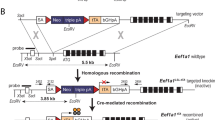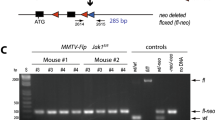Abstract
The ErbB2 receptor tyrosine kinase has been implicated as a critical growth factor receptor in both normal development and cancer. Amplification and overexpression of this receptor is observed in 20–30% of all human breast cancers and is inversely correlated with patient survival. Studies with transgenic mice have established that elevated expression of erbB2 in mammary epithelium can directly induce mammary carcinomas. Although these studies confirmed a role for ErbB2 in breast cancer induction, the precise role of ErbB2 in normal mammary gland development remained to be elucidated due to the embryonic lethality associated with the null mutation. Here, we demonstrate that the mammary-specific ablation of erbB2 through Cre-mediated recombination leads to a striking ductal elongation defect. In addition to the observed elongation defect, we noted that branching in the adult mammary gland was also reduced. Despite these perturbations in virgin mammary gland morphogenesis, targeted disruption of erbB2 had little impact on the ability of these animals to lactate. Taken together, these observations indicate that erbB2 plays a critical role in the initial stages of mammary gland morphogenesis.
This is a preview of subscription content, access via your institution
Access options
Subscribe to this journal
Receive 50 print issues and online access
$259.00 per year
only $5.18 per issue
Buy this article
- Purchase on Springer Link
- Instant access to full article PDF
Prices may be subject to local taxes which are calculated during checkout




Similar content being viewed by others
References
Andrechek ER, Hardy WR, Girgis-Gabardo AA, Perry RL, Butler R, Graham FL, Kahn RC, Rudnicki MA and Muller WJ . ( 2002 ). Mol. Cell. Biol., 22, 4714 – 4722 .
Andrechek ER, Hardy WR, Siegel PM, Rudnicki MA, Cardiff RD and Muller WJ . ( 2000 ). Proc. Natl. Acad. Sci. USA, 97, 3444 – 3449 .
Andrechek ER, Laing MA, Girgis-Gabardo AA, Siegel PM, Cardiff RD and Muller WJ . ( 2003 ). Cancer Res., 63, 4920 – 4926 .
Andrulis IL, Bull SB, Blackstein ME, Sutherland D, Mak C, Sidlofsky S, Pritzker KP, Hartwick RW, Hanna W, Lickley L, Wilkinson R, Qizilbash A, Ambus U, Lipa M, Weizel H, Katz A, Baida M, Mariz S, Stolk G, Dacamara P, Strongitharm D, Geddie W and McCready D . ( 1998 ). J. Clin. Oncol., 16, 1340 – 1349 .
Bouchard L, Lamarre L, Tremblay PJ and Jolicoeur P . ( 1989 ). Cell, 57, 931 – 936 .
Chaillet JR, Bader DS and Leder P . ( 1995 ). Genes Dev., 9, 1177 – 1187 .
Fowler KJ, Walker F, Alexander W, Hibbs ML, Nice EC, Bohmer RM, Mann GB, Thumwood C, Maglitto R and Danks JA . ( 1995 ). Proc. Natl. Acad. Sci. USA., 92, 1465 – 1469 .
Garrett TP, McKern NM, Lou M, Elleman TC, Adams TE, Lovrecz GO, Kofler M, Jorissen RN, Nice EC, Burgess AW and Ward CW . ( 2003 ). Mol. Cell., 11, 495 – 505 .
Guy CT, Cardiff RD and Muller WJ . ( 1996 ). J. Biol. Chem., 271, 7673 – 7678 .
Jones FE, Jerry DJ, Guarino BC, Andrews GC and Stern DF . ( 1996 ). Cell Growth Differ., 7, 1031 – 1038 .
Jones FE and Stern DF . ( 1999 ). Oncogene, 18, 3481 – 3490 .
Jones FE, Welte T, Fu XY and Stern DF . ( 1999 ). J. Cell Biol., 147, 77 – 88 .
Lee KF, Simon H, Chen H, Bates B, Hung MC and Hauser C . ( 1995 ). Nature, 378, 394 – 398 .
Long W, Wagner KU, Lloyd KC, Binart N, Shillingford JM, Hennighausen L and Jones FE . ( 2003 ). Development, 130, 5257 – 5268 .
Mukherjee S, Louie SG, Campbell M, Esserman L and Shyamala G . ( 2000 ). Oncogene, 19, 5982 – 5987 .
Muller WJ, Sinn E, Pattengale PK, Wallace R and Leder P . ( 1988 ). Cell, 54, 105 – 115 .
Sebastian J, Richards RG, Walker MP, Wiesen JF, Werb Z, Derynck R, Hom YK, Cunha GR and DiAugustine RP . ( 1998 ). Cell Growth Differ., 9, 777 – 785 .
Siegel PM, Ryan ED, Cardiff RD and Muller WJ . ( 1999 ). EMBO J., 18, 2149 – 2164 .
Slamon DJ, Clark GM, Wong SG, Levin WJ, Ullrich A and McGuire WL . ( 1987 ). Science, 235, 177 – 182 .
Slamon DJ, Godolphin W, Jones LA, Holt JA, Wong SG, Keith DE, Levin WJ, Stuart SG, Udove J and Ullrich A . ( 1989 ). Science, 244, 707 – 712 .
Soriano P . ( 1999 ). Nat. Genet., 21, 70 – 71 .
Zhou H, Chen WD, Qin X, Lee K, Liu L, Markowitz SD and Gerson SL . ( 2001 ). Oncogenesis, 20, 6009 – 6017 .
Acknowledgements
This work was supported by a CIHR grant awarded to WJM. WJM is also the recipient of a CRC Chair position. ERA was supported by a DOD predoctoral scholarship during this research – DAMD17-99-1-9285.
Author information
Authors and Affiliations
Corresponding author
Additional information
Supplementary Information accompanies the paper on Oncogene website (http://www.nature.com/onc)
Supplementary information
Rights and permissions
About this article
Cite this article
Andrechek, E., White, D. & Muller, W. Targeted disruption of ErbB2/Neu in the mammary epithelium results in impaired ductal outgrowth. Oncogene 24, 932–937 (2005). https://doi.org/10.1038/sj.onc.1208230
Received:
Revised:
Accepted:
Published:
Issue Date:
DOI: https://doi.org/10.1038/sj.onc.1208230
Keywords
This article is cited by
-
ERBB Receptors and Their Ligands in the Developing Mammary Glands of Different Species: Fifteen Characters in Search of an Author
Journal of Mammary Gland Biology and Neoplasia (2023)
-
Cancer stem cells and cells of origin in MMTV-Her2/neu-induced mammary tumorigenesis
Oncogene (2013)
-
Met signaling regulates growth, repopulating potential and basal cell-fate commitment of mammary luminal progenitors: implications for basal-like breast cancer
Oncogene (2013)
-
Integrated morphodynamic signalling of the mammary gland
Nature Reviews Molecular Cell Biology (2011)
-
ErbB/EGF Signaling and EMT in Mammary Development and Breast Cancer
Journal of Mammary Gland Biology and Neoplasia (2010)



